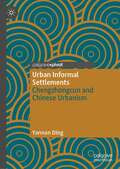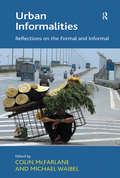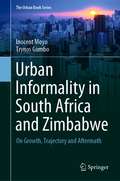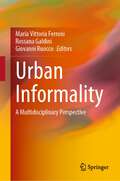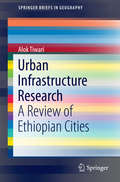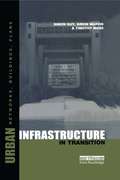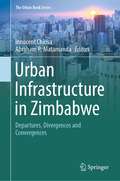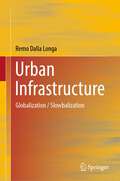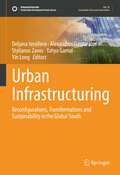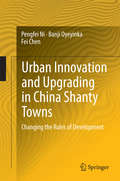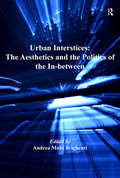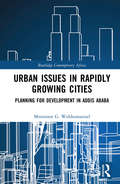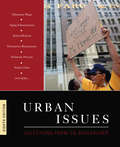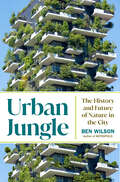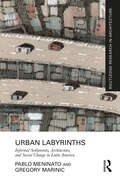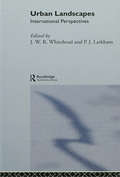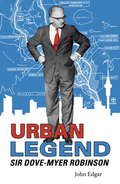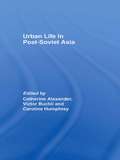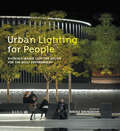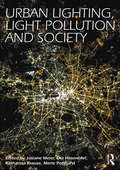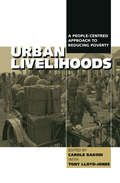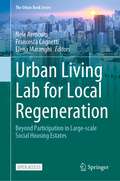- Table View
- List View
Urban Inequalities: A Multidimensional and International Perspective (The Urban Book Series)
by Graciela H. TononThis book proposes an interdisciplinary and multidimensional perspective of urban inequalities based on a range of theoretical, methodological, and professional approaches. Chapters consider different types of inequalities: in health, education, age, housing, energy, space, civic rights, social exclusion, ethnicity, poverty, segregation, work status, nutrition, public policies, democracy, human rights, technology, digital learning, subjective well-being, environment, and climate change. Contributions analyze the situation of different groups: children, youth, and indigenous people. The book highlights the importance of policy-making to overcome inequalities and addresses the key role of citizen participation.
Urban Informal Settlements: Chengzhongcun and Chinese Urbanism
by Yannan DingThis book offers a concise and yet diverse study on the Chengzhongcun. It has a broader scope, both geographical and temporal, than existing works on this topic. The typical Chinese urban informal settlement is related to morphologically similar communities to be found elsewhere in the world. The chapters’ themes were inspired by the methods in historical geography, citizenship studies, and new cultural geography. What is truly unique to this book is that ten years after the basis material of this book was defended, it is enriched with practical experience and first-hand observations of the rapidly changing Chinese city. As urbanization in China slows, this book will interest sociologists, urbanists and scholars of China.
Urban Informalities: Reflections on the Formal and Informal
by Michael WaibelBringing together an interdisciplinary and international group of researchers working on a wide variety of cities throughout Asia, Latin America and Europe, this book addresses, rethinks and, in some cases, abandons the notions of formal and informal urbanism. This collection critically interrogates both the ways in which 'informal' and 'formal' are put to work in the governing and politicisation of cities, and their conceptual strengths and weaknesses. It does so by focusing on a wide variety of topics, from specific forms of housing and labour often traditionally linked to the formal/informal divide, to urban political negotiations, cultural practices, and ways of being in the city. The book takes stock of and reflects on how contemporary urban informality/formality relations are being produced and are/might be understood, and puts forward an enlarged and comprehensive understanding of urban informality.
Urban Informality in South Africa and Zimbabwe: On Growth, Trajectory and Aftermath (The Urban Book Series)
by Inocent Moyo Trynos GumboThis book adds to the research of urban informality in the Global South with a specific focus on South Africa and Zimbabwe. It addresses the agency and the potential transformative capacity of the phenomenon of urban informality in connection with Southern African cities and towns. It adopts a political economy approach to analyse the evolution of informality in cities and its implications for urban planning. It brings to bear how the South African and Zimbabwean historical and/or ideological and contemporary political and economic trajectories have impacted on the ever changing nature of urban informality, both spatially and structurally and/or compositionally; thus resulting in unique urban materialities, which are aspects that have scarcely been studied or discussed in the extant literature. This book, therefore, seeks to close the academic gap by dealing with the dearth of literature on spatial (re)locational discourses of urban informality.The work positions urban informality as a resilient force with potency in terms of political mobilisation and (re) shaping urban spaces. Though these are fundamental issues, they have received comparatively little attention, especially in literature that focuses on the Southern African region. Accordingly, undergraduate and post-graduate students, as well as academics in the fields of Urban Geography, Political Science, Development Studies, Sociology, Town and Regional Planning among others, will find the range of topics and depth of coverage in this book particularly valuable. Similarly, practitioners and activists on issues of urban informality and urban governance will find the book very useful.
Urban Informality: A Multidisciplinary Perspective
by Maria Vittoria Ferroni Rossana Galdini Giovanni RuoccoThis book analyzes the informal practices of contemporary cities through a close dialogue between different research perspectives, with the shared goal of giving voice to informality and evaluating its benefits and potential in a multidimensional key of social factors. Recently, the human sciences have seen the emergence of this new term “informality,” at first sight in conflict with their function of giving order and form to social phenomena. A term with which, in this book, the authors, having as reference the Italian and European experience, specifically identify those unsatisfied social demands and those collective actions “from below” that aim at the recovery of urban space and the renewal of its organization, often not following the trajectories of legality and institutions. By means of a close dialogue between different areas of social research, this book attempts to establish the different declinations and applications of the term, evaluating the causes and effects, benefits, and potential of the phenomena attributable to it, within a multidimensional analysis that calls into question the regeneration and collective use of spaces, political-institutional confrontation and conflict, legal innovation, and social-economic benefits.
Urban Infrastructure Research
by Alok TiwariThis bookreviews contemporary research on urban infrastructure in 76 Ethiopian cities. It examines urban infrastructure issues in these cities and covers a wide rangeof topics from sustainability and smart cities to research methods employed byurban infrastructure investigators with regard to Ethiopian cities. Research onurban infrastructure legitimacies and modalities has established its valueworldwide in recent years, though it is still fairly young in the Ethiopiancontext. The first chapter outlines ongoing issues of debate concerning urbaninfrastructures, including but not limited to discourses on sustainability, smartcities, innovative financing methods, and potential partnerships. Urbaninfrastructure issues in Ethiopian cities are examined in the second chapter, whilethe third chapter presents a review of the most relevant literature forresearchers. Findings show that the citations in the research reports aremainly from the materials available over the internet, including WHO,UN-Habitat and unpublished local materials. The fourth chapter identifiespatterns in the findings and recommendations of the research reports discussed. The results reveal that there is a wider gap between supply and demand withregard to urban infrastructure in Ethiopian cities, a situation that is furtheraggravated because of the growing urban population and already existingbacklogs. The fifth chapter reviews the essential methods employed by urbaninfrastructure investigators in Ethiopian cities. In this regard, the cross-sectionalstudy method with the use of survey method has been broadly adopted amonginvestigators. Lastly, the book presents a summary and recommendations. It was observed that theurban infrastructure boom in Ethiopia is primarily concentrated in the keycities, and the current pattern of urban infrastructure provision does notincorporate the notion of sustainability. Hence, the book calls for setting theagenda of future research on urban infrastructure and services in Ethiopiancities together with the universities, private sector and government, who shouldideally collaborate to produce the knowledge needed to improve quality of life,welfare, productivity, and economic growth.
Urban Infrastructure in Transition: Networks, Buildings and Plans
by Timothy Moss Simon MarvinAchieving sustainable energy and resource use is vital if cities are to thrive or even function in the long term. Focusing on cities in the United Kingdom, Germany and Denmark, this book examines the mounting pressures for changes in the management style of utility services in Europe, pressures that stem from a wide range of sources such as liberalization and privatization of markets, tighter environmental standards, new economic incentives, competing technologies and changing consumption patterns. The authors show how changes in the management of utility services can contribute to achieving greater sustainability in urban regions. Whilst more efficient technology has a part to play, truly significant improvements in quality of life will be delivered only when the flow of material and energy through cities is focused on the goal of sustainability in each local context.
Urban Infrastructure in Zimbabwe: Departures, Divergences and Convergences (The Urban Book Series)
by Innocent Chirisa Abraham R. MatamandaThe book provides insights into urban infrastructure debates and discourses in Zimbabwe. Through an inter-disciplinary and multi-disciplinary approach, the book explores the theoretical, conceptual and lived experiences in urban infrastructure. The book focuses on case studies relating to urban transport, public housing, water and sanitation and Geographical Information Systems (GIS) among other substantive issues relating to urban infrastructure and services.
Urban Infrastructure: Globalization / Slowbalization
by Remo Dalla LongaThe book deals with the concept of urban infrastructure and the strong evolution of globalization, in particular the driving force taken by global cities. Urban infrastructure is a constituent part of the global cities, both have a synergistic evolution. The main reference is to western global cities in the intertwining of financialization, settling and brownfield which is a little different from the urbanization of other global cities of other non- developed countries, or emerging countries. There is therefore a significant link between globalization and urban infrastructure. The occurrence of slowbalization can have consequences on urban areas infrastructures and more generally on the different dichotomy between global city and nation. With the pandemic infectious and the post COVID, there is already a different configuration between the global city and the rest of the national territory. A driving element of the urban infrastructure and the global city has been the financialization and identification of assets within global cities. Urban infrastructure as an asset has grown considerably in the last two decades, in the wake of what has already been highlighted previously for real estate. There are contiguous issues that affect the concept of urban infrastructures and they are the enormous growth of finance and the landings of this in the great cities of the world with investments that first involved Real Estate and then urban infrastructures. There has also been a technological revolution that has merged the ubiquitous technological infrastructure with other more traditional components of the infrastructure, even apparently recent themes, such as smart cities, come from this evolutionary trend and merge with urban infrastructures. The theme of smart cities, if properly interpreted, gives strength to the concept of urban infrastructure.
Urban Infrastructuring: Reconfigurations, Transformations and Sustainability in the Global South (Sustainable Development Goals Series)
by Alexandros Gasparatos Deljana Iossifova Stylianos Zavos Yahya Gamal Yin LongThis book is about urban infrastructuring as the processes linking infrastructural configurations and their components with other social, ecological, political, or otherwise defined systems as part of urbanisation and globalisation in the Global South. It suggests that infrastructuring is essential to urbanisation and that it is entangled with socio-spatio-ecological transformations that often have negative outcomes over time. Furthermore, it argues that infrastructuring requires an ethical positioning in research and practice in order to enhance infrastructural sustainability in the face of intersecting environmental, social and economic crises. “Urban Infrastructuring” is developed in three parts. First, it identifies infrastructural entanglements across various urban and urbanising settings in the Global South. Second, it highlights some of the damaging processes and outcomes of urban infrastructuring and argues that the absence, presence and transformation of infrastructure in the Global South (re-)produces socioecological injustice in the short- and long term. Third, the book argues for a shift of infrastructuring agendas towards more just and sustainable interventions. It suggests that an ethico-politics of care should be embedded in systems approaches to infrastructuring in both research and practice. The edited volume contains contributions from authors with backgrounds in a variety of academic disciplines from the natural and social sciences, engineering and the humanities. It provides valuable insights for anyone concerned with the study, design, planning, implementation and maintenance of urban infrastructures to enhance human well-being and sustainability. It will be of interest to researchers and urban decision-makers alike.
Urban Innovation Networks
by Alexander GutzmerThis book offers fresh insights into how companies can engage with, and make use of, the modern metropolis. Based on actor-network theory and the resource-based view of the firm, it demonstrates how the contemporary city can be seen - and used - as a resource for corporate innovation. The main argument is that companies have to build what the author calls "urban innovation networks. " After a theory-based outline of such networks, the author demonstrates the extent to which different institutional players - companies such as Audi, Ikea and Siemens, but also arts institutions like the Haus der Kunst in Munich - are already working to create them. The book combines management thinking with urban theory and the sociology of networks to create a unique blend of different views of capitalism and space, offering a new perspective on both the modern metropolis and globally operating companies active within our distinctly urban culture.
Urban Innovation and Upgrading in China Shanty Towns
by Fei Chen Pengfei Ni Banji OyeyinkaBy using field survey and World Bank investment project evaluation method, this book investigates the experience of slum rebuilding in Liaoning province, China. It figures out that the experience of Liaoning province is relatively successful and can be of great significance for developing countries and regions. The issue of slums is a huge challenge in the process of global urbanization. The population living in slums is 0. 8 billion worldwide and the number is still growing. International organizations (e. g. , the World Bank) and relevant countries have been working on the rebuilding of slums but only a few succeeded. In recent years, since some scholars believe that government should play dominant role in slums rebuilding, Liaoning province has developed a systematical model in slums rebuilding from 2005. This model emphasizes the guidance of government, market functions and society involvement. With the application of the new model, Liaoning province has improved 2. 11 million people's living conditions from 2005 to 2010. By introducing the conditions, history, rebuilding process and rebuilding methods of Liaoning slums, this book provides new information and data for slum rebuilding decision makers and researchers.
Urban Interstices: The Aesthetics And The Politics Of The In-between
by Andrea Mubi BrighentiBringing together a team of international scholars with an interest in urban transformations, spatial justice and territoriality, this volume questions how the interstice is related to the emerging processes of partitioning, enclave-making and zoning, showing how in-between spaces are intimately related to larger flows, networks, territories and boundaries. Illustrated with a range of case studies from places such as the US, Quebec, the UK, Italy, Gaza, Iraq, India, and South-east Asia, the volume analyses the place and function of interstitial locales in both a ’disciplined’ urban space and a disordered space conceptualized through the notions of ’excess’, ’danger’ and ’threat’. Warning not to romanticize the interstice, the book invites us to study it as not simply a place but also a set of phenomena, events and social interactions. How are interstices perceived and represented? What is the politics of visibility that is applied to them? How to capture their peculiar rhythms, speeds and affects? On the one hand, interstices open up venues for informality, improvisation, challenge, and bricolage, playful as well as angry statements on the neoliberal city and enhanced urban inequalities. On the other hand, they also represent a crucial site of governance (even governance by withdrawal) and urban management, where an array of techniques ranging from military urbanism to new forms of value extraction are experimented. At the point of convergence of all these tensions, interstices appear as veritable sites of transformation, where social forces clash and mesh prefiguring our urban future. The book interrogates these territories, proposing new ways to explore the dynamics, events and visibilities that define them.
Urban Issues in Rapidly Growing Cities: Planning for Development in Addis Ababa (Routledge Contemporary Africa)
by Mintesnot G. WoldeamanuelThis book critically assesses the complex urban issues, planning challenges and development opportunities of rapidly growing cities, using Addis Ababa as a case study. Just like other developing cities, Addis Ababa is undergoing numerous natural and policy-driven changes. This book analyses the effect of these changes on urban management to allow better understanding of the conceptual frameworks that define the everyday functions of rapidly growing cities. It demonstrates that rapid urban growth has simultaneously created opportunities for economic development in the developing world as well as social, environmental and cultural challenges causing a mismatch between demand and the supply of services. The author argues that, by combining indigenous knowledge and practices and contemporary planning principles, developing countries can overcome challenges concerning environmental and public health, transport congestion, rising rents and house prices and lack of open space. Foregrounding the experience of everyday citizens of the city, this book aids our understanding of the nature of rapidly growing cities and outlines what needs to be done so that the city meets the needs of the people. A unique contribution to the literature on cities of the developing world, this book will be of interest to students and scholars of Urban Studies, Planning, Development Studies and African Studies.
Urban Issues: Selections from CQ Researcher
by Cq ResearcherWhat are the driving forces behind Smart Cities? What are the ramifications of increasing the minimum wage? What are the causes of aging infrastructure and how should they be addressed? These are just some of the provocative questions that are considered in the new edition of Urban Issues. For current coverage of urban politics, readers will appreciate the balanced and unbiased reporting of CQ Researcher. Urban Issues provides a window into how policy is created and implemented in America’s cities and is sure to spark classroom discussions. Each chapter examines the key players, stakes, background, and lessons for the future, while covering the range of facts, analyses, and opinions surrounding each issue.
Urban Issues: Selections from CQ Researcher
by Cq ResearcherWhat are the driving forces behind Smart Cities? What are the ramifications of increasing the minimum wage? What are the causes of aging infrastructure and how should they be addressed? These are just some of the provocative questions that are considered in the new edition of Urban Issues. For current coverage of urban politics, readers will appreciate the balanced and unbiased reporting of CQ Researcher. Urban Issues provides a window into how policy is created and implemented in America’s cities and is sure to spark classroom discussions. Each chapter examines the key players, stakes, background, and lessons for the future, while covering the range of facts, analyses, and opinions surrounding each issue.
Urban Jungle: The History and Future of Nature in the City
by Ben WilsonIn this exhilarating look at cities, past and future, Ben Wilson proposes that, in our world of rising seas and threatening weather, the natural world may prove the city's savior.Since the beginning of civilization, humans have built cities to wall nature out, then glorified it in beloved but quite artificial parks. In Urban Jungle Ben Wilson—the author of Metropolis, a seven-thousand-year history of cities that the Wall Street Journal called &“a towering achievement&”—looks to the fraught relationship between nature and the city for clues to how the planet can survive in an age of climate crisis.Whether it was the market farmers of Paris, Germans in medieval forest cities, or the Aztecs in the floating city of Tenochtitlan, pre-modern humans had an essential bond with nature. But when the day came that water was piped in and food flown from distant fields, that relationship was lost. Today, urban areas are the fastest-growing habitat on Earth and in Urban Jungle Ben Wilson finds that we are at last acknowledging that human engineering is not enough to protect us from extremes of weather. He takes us to places where efforts to rewild the city are under way: to Los Angeles, where the city&’s concrete river will run blue again, to New York City, where a bleak landfill will be a vast grassland preserve. The pinnacle of this strategy will be Amsterdam: a city that is its own ecosystem, that makes no waste and produces its own energy. In many cities, Wilson finds, nature is already thriving. Koalas are settling in Brisbane, wild boar may raid your picnic in Berlin. Green canopies, wildflowers, wildlife: the things that will help cities survive, he notes, also make people happy.Urban Jungle offers the pleasures of history—how backyard gardens spread exotic species all over the world, how war produces biodiversity—alongside a fantastic vision of the lush green cities of our future. Climate change, Ben Wilson believes, is only the latest chapter in the dramatic human story of nature and the city.
Urban Labyrinths: Informal Settlements, Architecture, and Social Change in Latin America (Routledge Research in Architecture)
by Gregory Marinic Pablo MeninatoUrban Labyrinths: Informal Settlements, Architecture, and Social Change in Latin America examines intervention initiatives in informal settlements in Latin American cities as social, spatial, architectural, and cultural processes. From the mid-20th century to the present, Latin America and other regions in the Global South have experienced a remarkable demographic trend, with millions of people moving from rural areas to cities in search of work, healthcare, and education. Without other options, these migrants have created self-built settlements mostly located on the periphery of large metropolitan areas. While the initial reaction of governments was to eliminate these communities, since the 1990s, several Latin American cities began to advance new urban intervention approaches for improving quality of life. This book examines informal settlement interventions in five Latin American cities: Rio de Janeiro, Medellín, São Paulo, Buenos Aires, and Tijuana. It explores the Favela-Bairro Program in Rio de Janeiro during the 1990s which sought to improve living conditions and infrastructure in favelas. It investigates projects propelled by Social Urbanism in Medellín at the beginning of the 2000s, aimed at revitalizing marginalized areas by creating a public transportation network, constructing civic buildings, and creating public spaces. Furthermore, the book examines the long-term initiatives led by SEHAB in São Paulo, which simultaneously addresses favela upgrading works, water pollution remediation strategies, and environmental stewardship. It discusses current intervention initiatives being developed in informal settlements in Buenos Aires and Tijuana, exploring the urban design strategies that address complex challenges faced by these communities. Taken together, the Latin American architects, planners, landscape architects, researchers, and stakeholders involved in these projects confirm that urbanism, architecture, and landscape design can produce positive urban and social transformations for the most underprivileged.This book will be of interest to students, researchers, and professionals in planning, urbanism, architecture, urban design, landscape architecture, urban geography, public policy, as well as other spatial design disciplines.
Urban Landscapes: International Perspectives (Institute Of British Geographers Special Publication)
by P. J. Larkham J. W. R. WhitehandTaking a multidisciplinary approach this addresses the academic and practical issues concerning the present and future of the built environment, arguing for its enlightened management in the future of our present-day environment.
Urban Legend - Sir Dove-Myer Robinson: Sir Dove-myer Robinson
by John EdgarEvery Aucklander of a certain age knows that we should have listened to Mayor Robbie back in the 1970s' - Labour Party MP Phil Twyford. But who was he? And why is he still relevant today? From a working class Jewish boy in Sheffield to long serving Mayor of Auckland (1959-1980), Sir Dove-Myer Robinson's life followed an unusual path. A slight, bespectacled man whose tiny stature was offset by a booming voice and massive ego, he was a natural political campaigner. Associated with a host of local and national causes, he became Auckland's most recognisable spokesperson. He joined political causes and challenged convention. He fought for our current waste water treatment process, against French nuclear testing, and an integrated Auckland transport system and city. Though his political career was outstanding and memorable, his personal life was a hot bed of gossip. Four wives, one 20 years his junior, and a very public divorce during one of his terms meant he was never far from the headlines. In this book we look at both his personal life and his outstanding political career, which affected not only the future of Auckland, but the future of New Zealand.
Urban Life in Post-Soviet Asia
by Caroline Humphrey Victor Buchli Catherine AlexanderCapturing a unique historical moment, this book examines the changes in urban life since the collapse of the Soviet Union from an ethnographic perspective, thus addressing significant gaps in the literature on cities, Central Asia and post-socialism. It encompasses Tashkent, Almaty, Astana and Ulan-Ude: four cities with quite different responses to the fall of the Soviet Union. Each chapter takes a theme of central significance across this huge geographical terrain, addresses it through one city and contextualizes it by reference to the other sites in this volume. The structure of the book moves from nostalgia and memories of the Soviet past to examine how current changes are being experienced and imagined through the shifting materialities, temporalities and political economies of urban life. Privatization is giving rise to new social geographies, while ethnic and religious sensibilities are creating emergent networks of sacred sites. But, however much ideologies are changing, cities also provide a constant lived mnemonic of lost configurations of ideology and practice, acting as signposts to bankrupted futures. Urban Life in Post-Soviet Asia provides a detailed account of the changing nature of urban life in post-Soviet Asia, clearly elucidating the centrality of these urban transformations to citizens’ understandings of their own socio-economic condition.
Urban Lighting for People: Evidence-Based Lighting Design for the Built Environment
by Navaz DavoudianLighting has the power to illuminate and enhance our experience within the built environment. The light that enables people to travel around their neighbourhood or their city; the light which they see themselves and their neighbourhood under. Research into the effects of urban lighting on behaviour, environmental psychology and social interaction is developing at a rapid rate. Yet, despite the affect it has on our daily lives, the practical application of this research is a relatively untapped resource. This book explores the needs and experiences of people at night and how these can be addressed by public lighting. It will give readers the confidence to develop more sophisticated lighting plans and add value to their projects. Case studies provide in-depth analysis of real-life projects and will help the reader to understand lighting designers’ own experiences, including post-installation observations. Written in an accessible style by an array of experts, this is an essential book for practitioners, academics and students alike, that will enable you to put the research in to practice and develop better lighting for better places.
Urban Lighting, Light Pollution and Society
by Josiane Meier Ute Hasenöhrl Katharina Krause Merle PottharstAfter decades "in the shadows", urban lighting is re-emerging as a matter of public debate. Long-standing truths are increasingly questioned as a confluence of developments affects lighting itself and the way it is viewed. Light has become an integral element of place-making and energy-saving initiatives alike. Rapidly evolving lighting technologies are opening up new possibilities, but also posing new challenges to planners, and awareness is growing that artificial illumination is not purely benign but can actually constitute a form of pollution. As a result, public policy frameworks, incentives and initiatives are undergoing a phase of innovation and change that will affect how cities are lit for years to come. The first comprehensive compilation of current scientific discussions on urban lighting and light pollution from a social science and humanities perspective, Urban Lighting, Light Pollution and Society contributes to an evolving international debate on an increasingly controversial topic. The contributions draw a rich panorama of the manifold discourses connected with artificial illumination in the past and present – from early attempts to promote new lighting technologies in the late 19th and early 20th centuries to current debates on restricting its excessive usage in public space and the protection of darkness. By bringing together a cross-section of current findings and debates on urban lighting and light pollution from a wide variety of disciplines, it reflects that artificial lighting is multifaceted in its qualities, utilisation and interpretation. Including case studies from the United States, Europe, and the UK, Urban Lighting, Light Pollution and Society is one of the first to take a serious assessment of light, pollution, and places and is a valuable resource for planners, policy makers and students in related subjects.
Urban Livelihoods: A People-centred Approach to Reducing Poverty
by Carole Rakodi Tony Lloyd-JonesOne of the most promising approaches to poverty reduction in developing countries is to encourage sustainable livelihoods for the poor. This takes account of their opportunities and assets and the sources of their vulnerability. Based on recent and extensive research, this volume thoroughly assesses the value of the livelihoods approach to urban poverty. The book reviews the situation and strategies of the urban poor and identifies the policies and practical programmes that work best. Lasting improvements depend not just on economic development, but on political commitment and structures that are responsive to the claims and needs of different groups of poor people.
Urban Living Lab for Local Regeneration: Beyond Participation in Large-scale Social Housing Estates (The Urban Book Series)
by Nele Aernouts Francesca Cognetti Elena MaranghiThis open access book provides an integrated overview of the challenges and resources of large-scale social housing estates in Europe and outlines possible interdisciplinary approaches and tools to promote their regeneration. It especially focuses on the tool of urban living labs, as promising in promoting new and more effective local governance and in including the different actors into the planning process. The book combines theory and practice, since it is the result of action-research conducted in different social housing estates all over Europe.Building on the results of the SoHoLab project (2017–2020), the book benefits from a multidisciplinary perspective, since the researchers involved belong to the fields of anthropology, urban planning, architecture, urban sociology. The project combined theoretical reflections with the installation and/or the consolidation of Urban Living Labs, run by universities, in large social housing estates in three European cities: Brussels, Milan and Paris.

